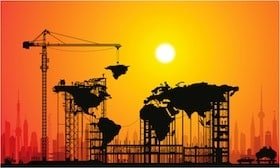 There’s no doubt that one of the biggest issues facing the planet and its inhabitants in the coming decades is how we treat the dual challenges of energy and the environment. For years, I’ve been advising my clients about one of the biggest trends related to these two issues: the rapid emergence of an intelligent energy infrastructure. It’s happening now – all around you – and the implications are pretty huge in terms of economic growth. The big question is, what role can accountants play as this infrastructure builds?
There’s no doubt that one of the biggest issues facing the planet and its inhabitants in the coming decades is how we treat the dual challenges of energy and the environment. For years, I’ve been advising my clients about one of the biggest trends related to these two issues: the rapid emergence of an intelligent energy infrastructure. It’s happening now – all around you – and the implications are pretty huge in terms of economic growth. The big question is, what role can accountants play as this infrastructure builds?
From a high level, the trend unfolding is that we will be able to more directly and individually control how we use energy resources, giving each of us ways to reduce our own environmental footprint.
We’re seeing small steps already today: for example, I just bought the new IP Thermostat app for my iPhone; it provides instant access to the two Internet-enabled Proliphix thermostats in my home and ski chalet/cottage. (I could link to my thermostats before via a web page, but IP Thermostat makes it seamless and fast.) The technology allows me to actively manage my energy consumption and better manage my environmental footprint. A world in which hundreds of millions of people are doing the same thing would put a serious dent into heating and air-conditioning usage.
Such devices are just a small example of a number of major trends that will lead to more of this type of connectivity becoming mainstream. For example, major industrial players are adding intelligence to the next generation of commercial, industrial and residential heating, ventilation and air-conditioning equipment, to allow for remote monitoring, management and rapid response to out-of-norm operations.
The advent of the “smart grid” – an electrical system that operates on a more efficient, cost-effective basis through the use of information technology – is another example. It’s not all hype; Cisco recently suggested that the connectivity component of energy infrastructure will be worth more than US$100 billion over five years. That’s some serious spending.
And if we consider the new role of analytics, in that such connectivity will allow consumers and users to better understand their usage, and allow more intelligent demand.
The Positive Energy initiative, for example, encourages hydro utilities to send out electrical bills that compare your usage to that of your neighbours. If you’re efficient, you get some smiley faces on your bill. If not, you get some images that would encourage you to do better. It’s a unique, simple idea, and yet it provides a glimpse into where we can go in the future if we allow people to take a more analytical, deeper view of how they use energy, and hence, impact the environment.
Imagine that as we build this intelligent, connected energy system we can provide tools allowing consumers to further manage their household energy use. For example, software tools could allow them to query an energy provider for details on how well their fridge was operating compared to neighbourhood norms, how much they could save by purchasing a more efficient microwave, or how much money they are losing by postponing that oil change on their 10-year-old hyper-connected car.
We know that everything around us is beginning to plug into the cloud.
There might be unique opportunities to consider how we can maximize the potential for insight as this occurs.




GET IN TOUCH
Jim's Facebook page
You'll find Jim's latest videos on Youtube
Mastodon. What's on Jim's mind? Check his feed!
LinkedIn - reach out to Jim for a professional connection!
Flickr! Get inspired! A massive archive of all of Jim's daily inspirational quotes!
Instagram - the home for Jim's motivational mind!